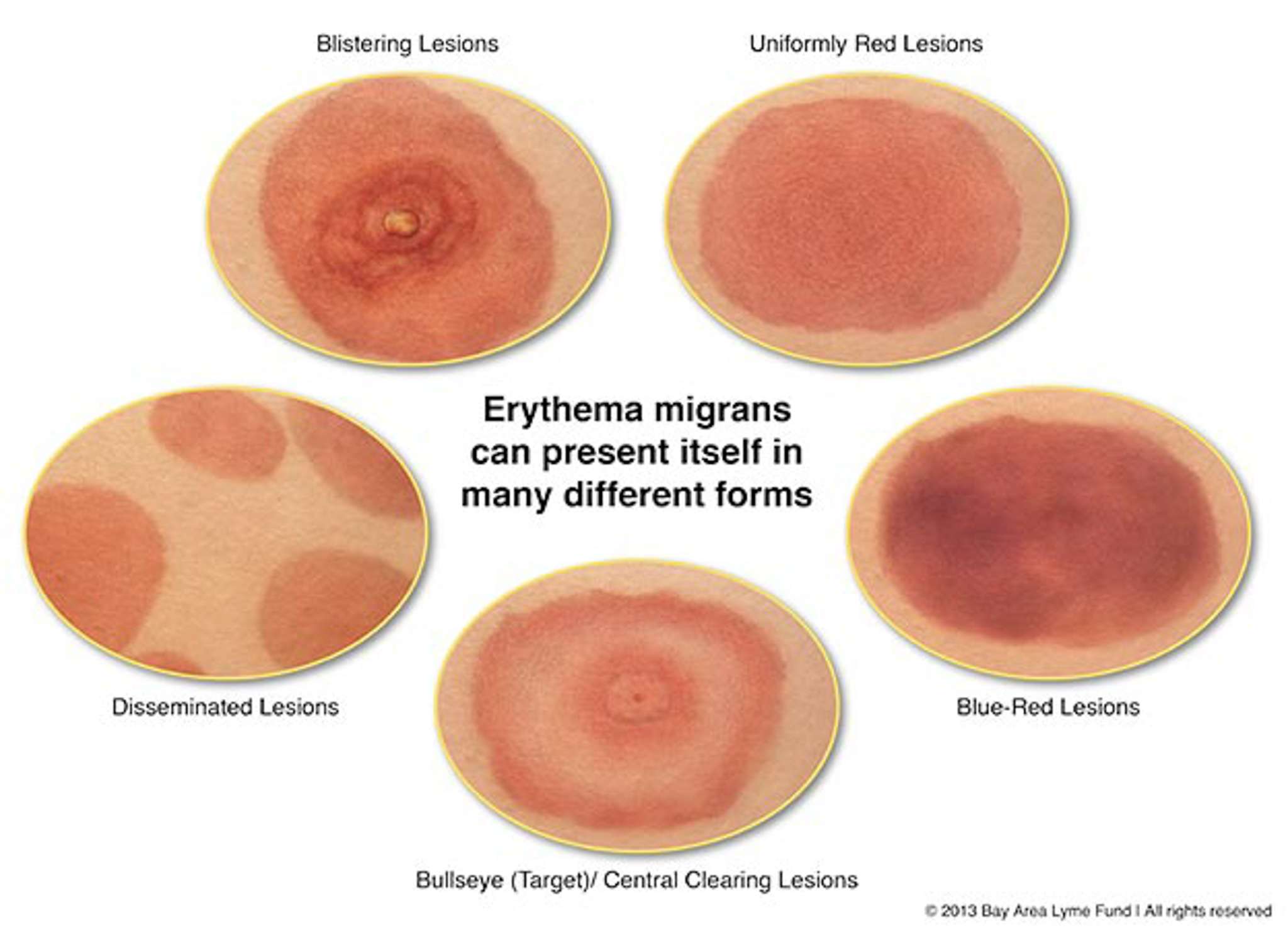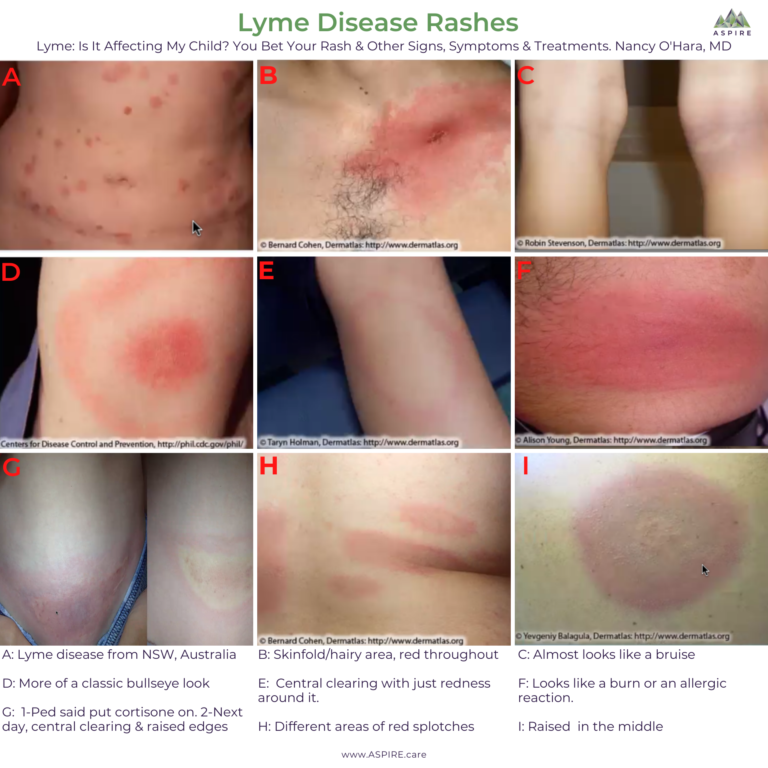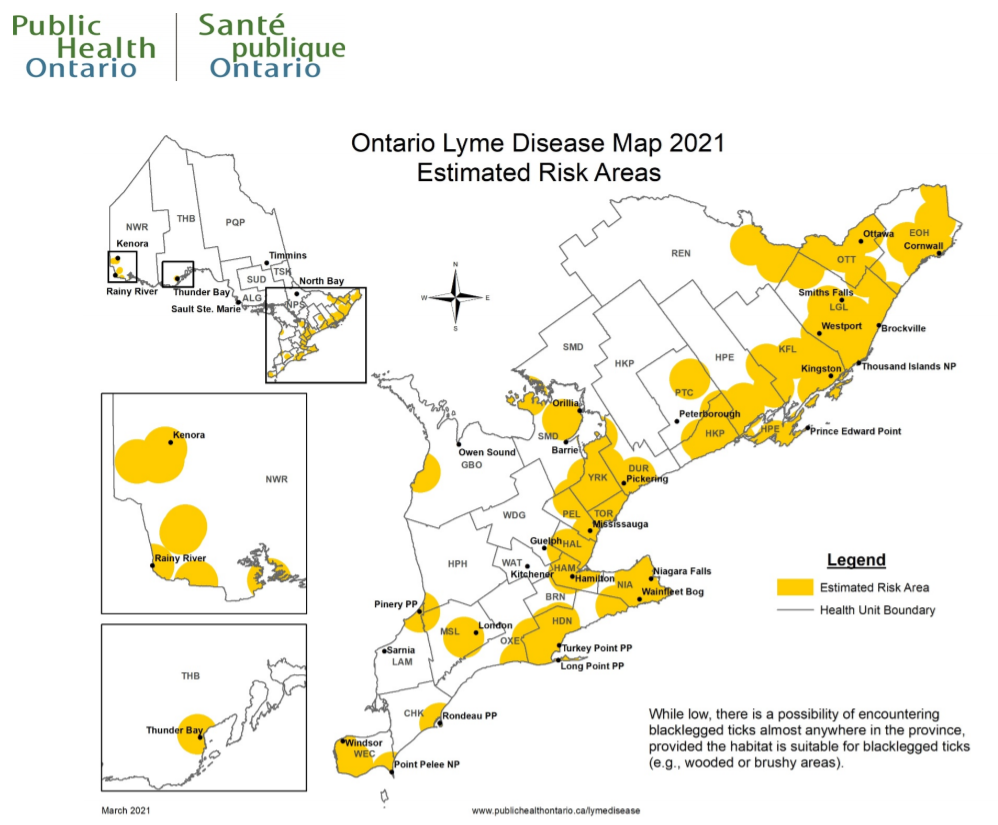Lyme Disease Signs And Symptoms
Most symptoms of Lyme disease in humans usually appear between three and 30 days after a bite from an infected blacklegged tick.
You should contact your local public health unit or speak to a health care professional right away if you have been somewhere that ticks might live and experience any of the following symptoms:
- rash
- a bulls-eye rash (a red patch on the skin that is usually round or oval and more than 5 cm that spreads outwards and is getting bigger
- a bruise-like rash
- another type of unusual rash
- muscle aches and joint pains
- fatigue
- swollen lymph nodes
- spasms, numbness or tingling
- facial paralysis
If not treated, Lyme disease can make you feel tired and weak and, if it gets really bad, it can even harm your heart, nerves, liver and joints. Symptoms from untreated Lyme disease can last years and include recurring arthritis and neurological problems, numbness, paralysis and, in very rare cases, death.
Which Areas Are More Likely To Have It
The tick that causes Lyme disease has been moving from the Northeast and upper Midwest into the Southern and Western U.S., Mexico, and Canada. Cases in California and Florida are on the rise. After a drop between 2017 and 2018, the numbers jumped a little bit in 2019.
But most Lyme cases in 2019 were in 15 states: Connecticut, Delaware, Maine, Maryland, Massachusetts, Minnesota, New Hampshire, New
Jersey, New York, Pennsylvania, Rhode Island, Vermont, Virginia, West Virginia, and Wisconsin. Washington, DC, is also a hotspot.
In 2019, Pennsylvania had the most Lyme infections, with 6,763. New York was next, with 2,847 cases.
In the Southern U.S., where itâs hotter, ticks stay under leaves so they don’t dry out. This means people donât get Lyme from Southern ticks very often because they don’t usually come out to bite.
Even though people only report about 30,000 cases of Lyme infection in the U.S. each year, there are actually around 476,000 a year. The same tick also can spread other diseases, including babesiosis, anaplasmosis, and Powassan virus. Those diseases are also on the rise in the U.S.
Whoâs likeliest to get Lyme disease?
Boys up to age 15 and men between the ages of 40 and 60 are the most likely to get Lyme disease. Thatâs because they tend to play outside and go camping, hunting, and hiking.
Why are there more ticks now than there used to be?
There are several reasons why Lyme is spreading. Some of these are:
Treatment For Neurological Lyme Disease
After defining the problem, she moves on to solutions. The next section deals with pharmaceutical approaches to Lyme disease in the brain, including an explanation of the blood-brain barrier and what drugs can effectively penetrate it. She discusses medications that reduce inflammation, as well as those to stabilize neurological function, balance mood and help people think more clearly.
Section 3 discusses natural approaches to Lyme disease in the brain: antimicrobials, such as Cats Claw and teasel root anti-inflammatories, such as curcumin and stephania root antioxidants, such as glutathione neurotransmitter support and essential oils such as peppermint and frankincense.
Section 4 deals with nutrition. Readers of her earlier book, The Lyme Diet, will find familiar themes: avoid gluten, dairy, sugar, caffeine, alcohol and additives such as MSG.
Ducharme explains about therapies to help the brain, including neurofeedback, Brainwave Entrainment, and hyperbaric oxygen. She covers sleep and exercise. She reviews different kinds of psychotherapy for patients with Lyme brain.
Recommended Reading: How Does Lyme Disease Affect The Brain
Learn The Stages Of Lyme Disease
Lyme disease occurs in three stages: early localized, early disseminated and late disseminated. However the stages can overlap and not all patients go through all three. A bulls-eye rash is usually considered one of the first signs of infection, but many people develop a different kind of rash or none at all. In most cases, Lyme symptoms can start with a flu-like illness. If untreated, the symptoms can continue to worsen and turn into a long-lived debilitating illness.
Stage 1: Early Localized Disease
Symptoms with early localized Lyme disease may begin hours, a few days or even weeks after a tick bite. At this point, the
infection has not yet spread throughout the body. Lyme is the easiest to cure at this stage.
Symptoms may include:
- skin rash, which may or may not look like a bulls eye
- flu-like illness, including chills and fever
- fatigue
- muscle soreness and joint pain
- swollen lymph nodes
- sore throat
Stage 2: Early Disseminated Lyme
Early disseminated Lyme may occur several weeks or months after the tick bite. Bacteria are beginning to spread throughout the body. In addition to flu-like symptoms, this stage is often characterized by increase in symptoms such as:
- chills
- pain, weakness or numbness in the arms, legs
- vision changes
- heart problems, such as palpitations, chest pain
- rash may appear on body
- facial paralysis
Stage 3: Late Disseminated Lyme Disease
Related Content
Find a LLMD
Lyme Symptom Tracker App
Get started with your diary
What Are The Complications Of Lyme Disease

Lyme disease affects people differently. Relapse and incomplete treatment responses happen. Relapse and incomplete treatment responses happen. Complications of untreated early-stage disease include:
-
Joint disease
-
Frequent hospitalizations to manage the disease
Some of these complications result in chronic, debilitating conditions.
Some people may develop post-Lyme disease syndrome . A condition also known as chronic Lyme disease includes PLDS, but also other syndromes. Usually, these are characterized by persistent musculoskeletal and peripheral nerve pain, fatigue, and memory impairment.
You May Like: What Medicine For Lyme Disease
How Is Lyme Disease Treated
Your healthcare provider will figure out the best treatment for you based on:
-
How old you are
Lyme disease in the earliest stage is usually treated with antibiotics for 2 to 3 weeks.
Treatment will also be considered based on these and other factors:
-
If you are bitten by a tick that tests positive for the bacteria that causes Lyme disease
-
If you are bitten by a tick and have any of the symptoms
-
If you are bitten by a tick and are pregnant
-
If you are bitten by a tick and live in a high-risk area
Key Points For Healthcare Providers
Dont Miss: Signs And Symptoms Of Lyme Disease In Child
Don’t Miss: What Antibiotics Treat Lyme Disease In Humans
When Should You See A Doctor If You Think You Have Lyme
The rash is a pretty good indication that you may have been bitten. Take a photo of the rash and see your doctor. At this stage, treatment with antibiotics will probably work.
If you don’t have the rash but have symptoms like fatigue, fever, and headache but no respiratory symptoms like a cough, you may want to talk to your doctor.
How Long Does Lyme Disease Last
They may last up to six months or longer. These symptoms can interfere with a persons normal activities and may cause emotional distress as a result. However, most peoples symptoms improve after six months to a year. Its not known why some people develop post-treatment Lyme disease syndrome and others dont.
Read Also: Can Lyme Disease Cause Seizures
Where These Ticks Are Found
Lyme disease ticks can be found in leaf litter, woodpiles, stone walls, tall grass, beach grass, bushy areas, areas planted with ground covers, and lawn edges that meet forests, woodlots, and gardens. Essentially, Lyme disease ticks can be found anywhere their hosts live, though they tend to prefer moist and shady areas. The deer tick is infected by vertebrate animals like white-footed mice, chipmunks, shrews, ground-feeding birds, and other small mammals that have Lyme disease bacteria themselves.
It Started With A Tick Bite How I Lost My Husband To Undiagnosed Lyme Disease
It was 2016 when I got a call at work. It was the house alarm company. My husband, Russ, who picked up the kids from school each day, had arrived home and wasnt able to turn the blaring alarm off.
I got home later that day and everything was fine. But I noticed Russ asking repetitive questions. Forgetting what time to pick up the kids. And he couldnt remember the alarm code the same one we had used for years.
In the time leading up to the alarm company incident, things between Russ and me had not been good. He was moody and irritable. He was angry. I thought we were headed toward divorce. But now I know those were the very first signs of tick-borne illness.
Because Russ was very outdoorsy, and because I knew he had ticks on him over the years, Lyme disease was actually one of the first things that came to mind when I started looking into the symptoms of my husbands cognitive decline. The thing was, though, that Russ had never had a fever or a rash associated with ticks that we knew of, and when tested with the standard Lyme screener had come up negative.
An MRI showed no stroke event. A PET scan showed severe deficiencies in metabolism patterns, consistent with late-stage Alzheimers. He was 60.
Russ was tested with a PCR test, the same way we now test for COVID-19, which looked for the organism itself rather than the antibodies. Russ had three tick-borne infections the three Bs as theyre known Borrelia , Bartonella and Babesia.
Related video:
You May Like: How To Kill Lyme Disease Naturally
What Blacklegged Ticks Look Like
Blacklegged ticks are small and hard to see. They attach themselves to humans and animals and feed on their blood. They can range in size depending on how long they have been feeding.
You can find out if its a blacklegged tick by:
- calling your local public health unit or checking their website
- submitting a photo of the tick to etick.ca
Adult female blacklegged tick at various stages of feeding. Photo: Government of Canada
Signs And Symptoms Of Lyme Disease

We include products we think are useful for our readers. If you buy through links on this page, we may earn a small commission. Heres our process.
Overview
Lyme disease is an underreported, under-researched, and often debilitating disease transmitted by spirochete bacteria. The spiral-shaped bacteria, Borrelia burgdorferi, are transmitted by blacklegged deer ticks. Lymes wide range of symptoms mimic those of many other ailments, making it difficult to diagnose .
The blacklegged ticks can also transmit other disease-causing bacteria, viruses, and parasites. These are known as coinfections . These ticks that transmit Lyme are increasing their geographical spread. As of 2016, they were found in about half the counties in 43 of 50 states in the United States .
Lyme is the fifth most reported of notifiable diseases in the United States, with an estimated 329,000 new cases found annually . Some studies estimate that there are as many as 1 million cases of Lyme in the United States every year .
Most people with Lyme who are treated right away with three weeks of antibiotics have a good prognosis.
But if youre not treated for weeks, months, or even years after infection, Lyme becomes more difficult to treat. Within days of the bite, the bacteria can move to your central nervous system, muscles and joints, eyes, and heart .
Here is a list of 13 common signs and symptoms of Lyme disease.
You May Like: Which Ticks Give You Lyme Disease
Don’t Miss: Functional Medicine And Lyme Disease
Pearls And Other Issues
Based on the geographic distribution of the shared vector Ixodes scapularis, co-infections with Lyme disease and human granulocytic anaplasmosis and/or babesiosis can occur. Co-infected patients may be more severely ill at presentation, have a persistent fever longer than 48 hours after initiating antibiotic therapy for Lyme disease, or present with anemia, leukopenia, and/or thrombocytopenia. When co-infection is suspected or confirmed, treatment with an appropriate antimicrobial regimen for each infection is necessary for resolution of illness.
What Are The Treatments For Lyme Disease
Lyme disease is treated with antibiotics. The earlier you are treated, the better it gives you the best chance of fully recovering quickly.
After treatment, some patients may still have pain, fatigue, or difficulty thinking that lasts more than 6 months. This is called post-treatment Lyme disease syndrome . Researchers don’t know why some people have PTLDS. There is no proven treatment for PTLDS long-term antibiotics have not been shown to help. However, there are ways to help with the symptoms of PTLDS. If you have been treated for Lyme disease and still feel unwell, contact your health care provider about how to manage your symptoms. Most people do get better with time. But it can take several months before you feel all better.
You May Like: Lyme Disease Treatment Germany Hyperthermia
How Is Lyme Disease Spread
Not all deer ticks are infected with the bacteria that cause Lyme disease. Ticks can become infected if they feed on animals such as mice and other mammals that are infected. The disease can be spread when an infected tick bites a person and stays attached for a period of time. In general, the tick must be attached for 36 to 48 hours or more. Lyme disease does not spread from one person to another. Transfer of the bacteria from an infected pregnant woman to her fetus is extremely rare.
How Can You Reduce Tick Habitats Near Your Home
Here are some ways to limit exposure to ticks near your home:
- Mow the lawn regularly to keep the grass short
- Remove leaf litter, brush and weeds at the edge of the lawn and around stonewalls and woodpiles
- Stack firewood neatly and in a dry area
- Put barriers to exclude deer around your home and seal stonewalls and small openings to discourage rodent activity
- Place childrens recreational playground sets, patios and decks away from the yard edges and trees. Place them on a woodchip or mulch foundation and in a sunny location, if possible.
- Treat pets that are commonly exposed to ticks with oral or topic acaricides as they could carry ticks into the home
Dont Miss: Cost Of Western Blot Test For Lyme
Also Check: How To Check For Lyme Disease
How Long Does It Take The Tick To Transmit Lyme
Experts disagree about how long it takes a tick to transmit Lyme disease. The CDC says that in most cases, the tick must be attached more than 24 hours.
We think that gives people a false sense of security. In some research studies, 5-7% of nymphs transmitted the Lyme bacteria in less than 24 hours. One paper reported on a case of Lyme disease transmitted after six hours of tick attachment. The risk may be low the first day, but its not zero.
Furthermore, some studies show that only 30% of patients with Lyme disease recall a tick bite. If people dont even realize that they were bitten, how could they know how long the tick was attached?
The longer a tick stays on you, the more likely it will transmit disease. Its important to find and remove any tick as soon as possible.
What Should I Do If I Am Bitten By A Tick
If you experience a tick bite, the best way to remove it is by taking the following steps:
- Tug gently but firmly with blunt tweezers near the “head” of the tick at the level of your skin until it releases its hold on the skin.
- Avoid crushing the tick’s body or handling the tick with bare fingers as you could exposure yourself to the bacteria in the tick.
- Wash the bite area thoroughly with soap and water.
- DO NOT use kerosene, petroleum jelly , or hot cigarette butts to remove the tick.
- DO NOT squeeze the tick’s body with your fingers or tweezers.
Don’t Miss: Washington Dc Lyme Disease Specialist
Can Lyme Disease Change Your Personality
Neuropsychiatric symptoms are prominent. Lyme patients tend to have trouble with mood regulation, cognition, energy, sensory processing, and/or sleep. This can manifest into paranoia, hallucinations, mania, and/or obsessive-compulsive behaviors. Memory loss and concentration issues mirror other psychological disorders.
Recommended Reading: Homes For Sale Old Lyme Ct
Why Is Tick Surveillance Important

Lindsay said Canada continuously have potential threats of other species of ticks from the southern U.S. finding a home in Canada.
The ones that were most concerned about are Lone Star Ticks, said Lindsay. We do see small numbers of those things coming into the country each year. But as far as we know, we dont have populations.
Lone star ticks could trigger an allergy to red meat as a sugar in the ticks saliva triggers an immune response in humans according to a 2017 Global New article.
Lindsay said there is also the Asian longhorned tick establish in several areas in certain northern states in the U.S., and they can cause both veterinarian and human health implications.
To date, Canada we have not even seen any specimens of that particular tick, said Lindsay. But were we need this surveillance network in order to keep tabs on those emerging tick-borne threats.
Lindsay said there is a healthy population of American dog ticks throughout Manitoba and Saskatchewan, which have helped residents know how to deal with ticks. However, he said other parts of the country might have less experience with ticks.
I think using something like eTick will help you to educate yourself about what ticks are or where they are located, he said.
eTick is an online public platform for image-based identification and population monitoring of ticks in Canada.
Lindsay said many different fact sheets and information are also available to the public on PHACs website.
Also Check: What To Do If You Get Lyme Disease